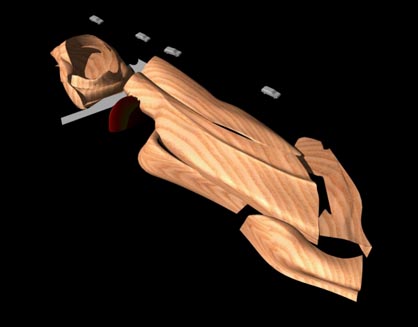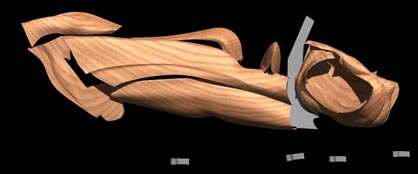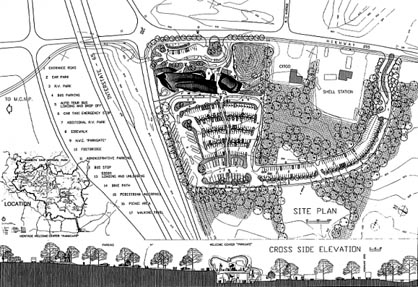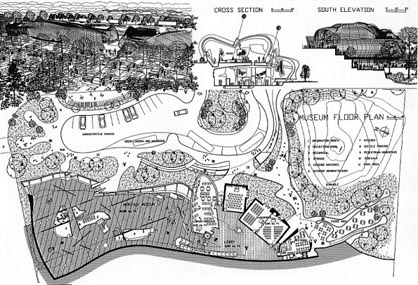|
|
||||
| AMERIGO QUAGLIANO, SILVANA FELEPPA. Heritage Welcome Center |
||||
|
[in italiano] |
The new Heritage Welcome Center has been conceived as a complex structure, an intermodal traffic junction, equipped with welcome services and visitors' interconnection with the Mammoth Cave National Park, Park City and the HWY 31W Heritage Corridor. It is an organism which makes up a whole with the urban functions and represents an interface between man and nature, a transition point for reception and spread of environmental information. Its architecture is interpreted as a system of passages, crossings and integration between structure and landscape through a series of bodies freely arranged on the ground, which thus makes it possible to be connected to the surrounding context which in its turns penetrates into the spaces among the bodies producing a great flexibility. A symbol of that is the gate, the way through which visitors pass to go to the Park, that's why the plan is called "PARKGATE"; another symbol is the bridge as pedestrian crossing found in several iconographic traditions, essence of the idea di passage, link between two physical places. The affirmation of the "mountain as sculptural energy" is the other idea at the basis of the plan, as in the sculptor Henry Moore's lying figures and so steep masses and majestic curves which close them in their reciprocal returns match with the solemnity of a landscape that always contains them ideally. In it the images with their mysterious protuberance can evoke a body as an organic concretion; the curved line predominates, it consists of a continuous unwinding, thus expressing a vital and serpentine movement of the body, of the organic and metamorphic form which is not naturalistic but evocative of elementary forces of nature which make their mysterious growth be felt.  |
[30may2001] | ||
| Smooth surfaces alternate with squared holes which seal the form, winding curves which modulate it, remoulding the same theme of the geological stratification or the biomorphic growth in always various and new ways as inexhaustible chain, organic as well and prodicing inventions. Large slots and holes are wedged in the volumes or sometimes there are empty spaces which become a leitmotiv of the whole complex, whereas some cords are inserted on the inside of the excavated masses and from a top to the next one of the outstretched plastic arches, thus creating a dynamic counterpoint and a chiaroscuro shimmering. The "Parkgate" is designed as an archaic geoglyph, mindful of the zoomorphic designs of the Mounds' ancient autochthonous civilization, it develops on an area put in close integration with the surrounding ones, the town and the territory, especially the Mammoth Cave National Park with the Welcome Center which carries out the welcome and information function for visitors of the park and of the historical itinerary of the Hwy 31W. For visitors there will be a parking area that winds up the hill, in the assigned lot, shaped like a gigantic Proteus, the hypogean amphibious inhabitant, whose head, body and tail are recognizable.   |
Amerigo Quagliano (Castellammare di Stabia, NA, 1957) e
Silvana Feleppa (Sessa Aurunca, CE, 1958), si laureano in Architettura all'Universitą di Napoli nel 1986, col massimo dei voti. Collaborano a diversi progetti tra i quali: Riqualificazione dell'area di Novoli a Firenze e degli impianti delle FF. SS. a Napoli con Aldo Loris Rossi, restauro e ampliamento del Museo Hermitage a San Pietroburgo in Russia. Dal 1992 iniziano in proprio l'attivitą professionale a Napoli, dove vivono, occupandosi di progetti urbatettonici, sperimentandone un'ampia gamma. Contemporaneamente partecipano a diversi concorsi tra cui: "Europan 3", pubblicato in "L'Arca" n. 89 e il "Primo concorso nazionale per la progettazione di un campanile" opera segnalata e pubblicata in "CHIESA OGGI" anno VIII, n. 38\1999. |
|||
| The development follows the earth one but with some appropriate rectifications, one enters there from the Hwy 255 through a two-way traffic line, which is the proteus's flexuous tail; it is separated by a strip of turf where low bushes and shrubs with polychromatic inflorescence grow. The two-way access road leads up to the head, whereas at the body level there is a double parking area. On top the vehicular traffic flow is ring like, anti-clockwise and one way only and there are further parking places for the overall required 300 cars. At the bottom there are the places for the 25 Recreational Vehicles, provided with the appropriate services, with additional parking places along the ring-road and at last, along the northern margin of the lot, there are the places for the 25 buses. Inside the parking areas the traffic is two-way; from these areas the visitors reach the Welcome Center on foot without interfering with the main roads and in a perfectly safe way. In fact the ones who park along the proteus body make use of a large sidewalk on the east, whereas the ones who park on the top make use of a winding middle route among the trees. This latter is appropriately raised in comparison with the road level and is pointed out with traffic signs painted on the road surface, as well with traffic signs and light signals, the so called " sleeping policeman" system. The whole parking area is provided with suitable and shady zones lined with trees and a twilight installation. Not far from the Welcome Center there is a transportation loading and drop off parking area. The Visitor's Center is located in the gradient between the parking area standing above, where a retaining wall of the embankment is built, and the underlying area whose development is rectified and adjoining the Hwy 255. Dow the Welcome Center, in communication with the above said road, another two-way traffic line leads to a parking area for tour and transit vehicles, to the Administrative parking and to a zone for goods loading and unloading, as well as to an area used as park. As a continuity of the above described system of routes a foot-bridge, accessible from a passage created between the auditorium's emergent main body and the foyer links the roads for pedestrians and cyclists of the general network with the plan to building nearby a parking area for bicycles and also a pedestrian underpass towards the Mammoth Cave National Park that avoids the link road of the Interstate-65.   The Welcome Center develops on two interconnected superimposed levels, the former lying higher up is accessible from the visitors' parking area, it is characterized by a wide Foyer, the latter at the lower level from the Museum, whereas at an intermediate level there is the Theatre. At the first level there will be the welcome functions: the Foyer for the purpose of orientating the groups flocking into the Parkgate, a janitorial closets, a cloak room, the five computer work stations used by visitors, the bathrooms and besides an area of sale with a bookstore, a Gift shop, a Craft store and the offices. In the middle of the foyer space like a long cavern torn by a lot of cracks through which the light penetrates there is the information booth, on one side there is a waiting area from where one can enjoy wide views over the underlying Museum and the landscape. At level of the entrance overlooking the emergent body of the theatre, converging center of the flow of visitors, other introspective views over the underlying foyer of the theatre and further down of the museum allow the visitors an overall view of the Welcome Center. From this area by means of a descending ramp or alternatively by a large glazed lift one enters the auditorium level and then the Museum one. Proceeded by a foyer lit by skylights, the theatre can be divided in two autonomous parts by means of fireproof movable panels, thus allowing the alternate use of the space, it is further provided with external accesses for an use differentiated from that of the Visitors' Center, being also emergency exits. On the Museum floor there are the other planned functions: the library with a reading-room attached, the archives, the three classrooms, two of which can be joined for larger groups through movable panels with annexed areas for the external demonstrations and finally the public restroom, provided with the appropriate services, with open- air extensions when weather is fine and the picnic zone attached. This is reachable from the parking areas standing above by means of a ramp that goes through a zone equipped as a park. All the functions of this level are made independent by an equipped lobby accessible from the outside through a further Parkgate entrance, they act as basement of the theatre standing above and they are further turned toward the protected sinkhole area which is its scenic background. The Museum is conceived as an only double height showroom, whose conformation is like the interior of a ship and by means of light movable panels it can be subdivided in different ways according to the shows. In the middle zone there are different support accommodations whose shape reminds of calcite concretions, they are the projection room, the storages, the technical rooms and the bathrooms, whereas on the planned mezzanine floor there are multipurpose rooms. The daylight comes both from wide windows eastwards and by suitable skylights, a back door is further planned for the works to be exhibited. In case of need it acts as emergency exit. Altogether the surface for pedestrian traffic is no more than 15% of the whole area. The foundation structure of the Parkgate is planned in reinforced concrete including the control wall of the parking embankment, whereas the emergent structure in made with a double structure of arch trusses in multilayered wood placed one on top of the other and a curtain wall with multiplayer light panels and external finishing in planking of cedar-wood, whereas the party wall are made with light shaped multilayer paneling. The curtain walls of the classrooms and the restroom on which the theatre rests are made with reinforced concrete covered with local stone. All the frames are of wood with wired glasses and furthermore the use of underground ventilation ducts is planned for a summer coolness at right bioclimatic conditions. Amerigo Quagliano e Silvana Feleppa amerigo.quagliano@tin.it |
||||
| Heritage Welcome Center |
||||
| Il progetto č stato sviluppato in relazione all'omonimo concorso internazionale svoltosi nell'agosto del 2000. Il concorso prevedeva la progettazione di un Centro Servizi di accoglienza per i visitatori del Mammoth Cave National Park nel Kentuky. progetto: Amerigo Quagliano e Silvana Feleppa con la collaborazione di: Daniele Quagliano (CAD) |
||||
|
>
CONCORSI > HERITAGE DESIGN COMPETITION > ARCHITETTURE |
||||
per partecipare alla rubrica architetture laboratorio
|
||||